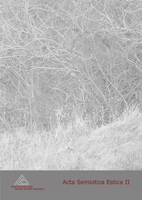Tekst intersemiootilises ruumis
Text in Intersemiotic Space
Author(s): Peeter ToropSubject(s): Semiotics / Semiology
Published by: Eesti Semiootika Selts
Keywords: culture; (creole) text; intersemiotic space; process(uality); rough draft; kultuur; (kreool)tekst; intersemiootiline ruum; protsess(uaalsus); mustand
Summary/Abstract: One parameter of studying culture as an intersemiotic space has been metacommunicative aspect. Each cultural artefact can be surrounded by a whole array of texts of different media and discourses that are all metatexts in relation to it. The theory of metatexts has tried to approach this situation by typologising metatexts; theories proceeding from intertextuality consider textual relations in intertextual communities more important. In the meeting point of intertextuality and metatextuality both post- and precommunicative processuality become important. On the one hand, culture is an endless perception and reception. The possibility for one artefact to appeal' in different materials, e.g. as a novel, film, ballet or a symphony, shifts the ontological borders of the artefact and makes it into an intricate and dynamic mental whole. But besides this also the processes of creation of artefacts have entered culture and culture has begun to resemble a writer's worksheet, covered with unrelated phrases, drawings, but also coherent thoughts. What is important is not their existence as such but their location on a sheet of paper that makes it possible to recreate the force field of thinking, to see an intricate whole in these fragments. Thus the creative process itself becomes an explicit part of culture and the receiver can communicate with not just a completed text but also with a possible world in which the text as it is has developed and in which also other kinds of developments could have taken place. A film in the cinema and on DVD can be of different lengths; a DVD can contain omitted shots and sequences, screen tests etc. Creative process has become a part of marketing and the text is diffused in media already before it is completed. Thus the traditional status of the original text or the prototext disappears and new means have to be found to carry out a holistic analysis. Not all texts are located in culture as wholes with definite borders and the diffuse creative process often merges with the diffuse receptive process before the text itself is recognized as an immanent whole in culture. It is the change in proportions of explicit and implicit properties of cultural artefacts that, in turn, presupposes the capability of the scholar analysing culture to respond to the new situation with new research strategies.
Journal: Acta Semiotica Estica
- Issue Year: 2005
- Issue No: 2
- Page Range: 011-020
- Page Count: 10
- Language: Estonian

